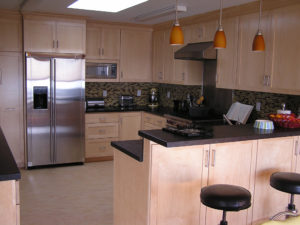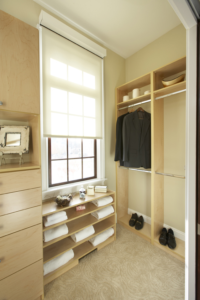4 Uses of Rotary Cut Maple Veneer
- November 13, 2017
- •
- by Columbia Forest Products
While the method of plain slice veneer production is common globally, this manufacturing process where a trimmed block of wood is affixed to a slicing machine and presented to a fixed knife which results in production of smaller component widths which can introduce challenges for architects, builders and cabinet makers to contend with. In comparison, rotary cut veneer production where an entire log is mounted in a lathe and turned or “peeled” against a lathe knife at once, allows for a thicker, longer, and wider “ribbon” of veneer giving the industry an alternative result at a lesser cost than plain sliced woods in many cases.
Rotary cut maple from Columbia Forest Products comes from forests of the United States and Canada, offers consistent thickness and methods of component assembly like slip matching and plank matching with “tight side out” to help reduce what is known as “ barber pole effect” when finishing. For architects, builders and craftsmen who want the best veneer possible for their projects, rotary cut maple veneers can deliver in unique ways.
Consider these four uses of rotary cut maple veneer plywood to see exactly where this material can truly excel.
Kitchen Cabinetry
One of the most popular kitchen door styles of today is the slab or plain front cabinet. This contemporary style requires a clean, sleek veneer that has a tight color range and little wood grain to detract from the lines of the room. Rotary cut maple veneer from Columbia has several veneer face matching options, which translates into a cohesive look from one cabinet door to the next across the entire kitchen.
The size of the veneers able to be produced from rotary cuts also means that oversized drawer fronts and pantry doors can also have the same clean lines. For contemporary spaces that want a hardwood cabinet door, rotary cut maple can make aesthetic sense.
Fabricators in particular appreciate the tight grain of maple which makes the species ideal for use in cabinet interiors, shelving, where durability and the visual appeal of real wood are desired.
Paneling
Appliance panels have long been a popular addition to many high-end homes, and now have begun to appear in contemporary kitchens of all types as well. Appliance panels are necessarily much larger than typical cabinet doors or drawers. In the slab style that’s become increasingly popular of late, a single panel veneer that can accommodate the length and width of larger appliances is useful.
Rotary cut white maple veneers offer a consistent, tight color range which takes stains, dyes and tints exceptionally well with a subtle wood grain which adds real authenticity to today’s contemporary kitchen. The same wood veneers can be used throughout the space as paneling, to cover not only appliances, but also end panels and islands to give contemporary kitchens the clean, sleek lines they need.
Custom Closet Doors & Shelving
As more homeowners begin looking at open floor plans and multi-functional rooms for their homes, they are also beginning to look at storage differently than before. For this reason, custom closets are becoming the norm, rather than the exception in many homes.
Custom closets also require custom closet doors, with the traditional bi-fold doors quickly being replaced by sleeker, multi-panel sliding doors that can accommodate the closet’s many uses. Rotary cut veneers are large enough to accommodate any size of sliding panel or door. At the same time, their ability to be easily matched and bookended means that you can create many different styles to complement several architectural styles as well including matching shelving inside for storage.
If the doors are to be painted, whole piece face rotary veneer finishes better with no visible splice lines which, regardless of sanding effort, can be seen in even opaque finishes as a line. Whole piece veneer faces are much easier to paint consistently than multiple component faces.
Furniture & Built Ins
Like many quality veneers, rotary maple is perfect for creating living room furniture and built ins as well. The consistent thickness on slip matched and plank matched appearance options mean that it’s possible to use the material in ways that make crafting easier, with less time spent on matching, grading, and joining. This also helps the woodworker prevent the barber pole effect from occurring.
Columbia’s rotary cut white maple veneers are generally thicker than plain sliced veneers. This means furniture builders simply have “more” wood to work with; allowing additional surface preparation, finishing alternatives, easier matching up of edge treatments with solid lumber. It is simply a more forgiving product to work with in many cases.
Columbia’s rotary maple veneers provide craftsmen, builders, and architects with “more.” More wood, more consistent material that’s more forgiving in many circumstances to work with, less expensive in many cases, and more consistent in color and grain as well. A switch to an investment in rotary cut veneer where it counts translates into the quality projects architects, builders, fabricators and ultimately, tenants and homeowners, can appreciate.






